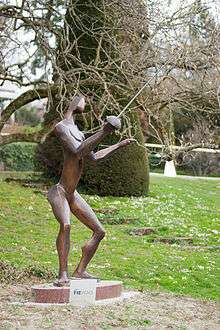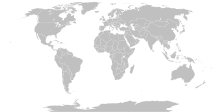Fédération Internationale d'Escrime
The Fédération Internationale d'Escrime (English: International Fencing Federation), commonly known by the acronym FIE, is the international governing body of Olympic fencing. Today, its head office is at the Maison du Sport International in Lausanne, Switzerland. The FIE is composed of 157 national federations,[1] each of which is recognized by its country's Olympic Committee as the sole representative of Olympic-style fencing in that country.
 | |
| Sport | Fencing |
|---|---|
| Founded | November 29, 1913 |
| President | Alisher Usmanov |
| Countries | 157 |
| Headquarters | |
| Official website | fie |

Since its inception in 1913, there have been fourteen different presidents. The current president of the federation is Alisher Usmanov.
History

The Fédération Internationale d'Escrime is the heir of the Société d'encouragement de l'escrime founded in France in 1882, which took part in the global movement of structuring sport.[2] The first international fencing congress was held in Brussels, Belgium in 1897 at the instigation of the Fédération belge des cercles d'escrime, followed by another one in Paris in 1900.[3] At this occasion the Société organised one of the first international fencing events; French, Italian, Spanish, and Belgian fencers attended the competition.[4] Dissensions rapidly arose between epeists and foilists, which held the majority at the Société. The third congress held in Brussels in 1905 voted the creation of an international fencing committee whose mission would be of fostering friendship amongst all fencers, establishing national rules, and supporting the organization of fencing competitions.[5] The 3rd congress also adopted the French rules as the basis for upcoming international competitions. New tensions appeared, this time between France and Italy, about the regulatory weapon grip. They led to the boycott by France of the fencing events of the 1912 Olympic Games.[6] A new international congress was called together in Ghent, Belgium, in July 1913. The main matter was the adoption of international regulations for each of the three weapons. The French rules were adopted in épée and foil; the Hungarian rules were chosen for sabre.[7] Frenchman René Lacroix also campaigned for the creation of an international fencing federation.
The Fédération Internationale d'Escrime was founded on November 29, 1913, in the conference rooms of the Automobile Club de France in Paris.[8] The nine founding nations were Belgium, Bohemia (now the Czech Republic), France, Great Britain, Hungary, Italy, the Netherlands, and Norway. Albert Feyerick, president of the Federation of fencing clubs of Belgium, was elected as the first president. The FIE held its first congress on June 23, 1914 and accepted the adhesion of seven new countries: Austria, Denmark, Monaco, Romania, Russia, Switzerland, and the United States.[9]
Events
Competitions organized by the FIE include the senior World Championships and World Cup, the Junior World Championships and Junior World Cup, the Cadets World Championships and the Veterans World Championships. The FIE delegates to regional confederations the organization of the zone championships.
The FIE assists the International Olympic Committee in the organization of fencing events at the Summer Olympics. The number of events is a matter of contention between the FIE and the CIO since the introduction of women's sabre at the 1999 World Championships: since then, the World Championships feature twelve events–an individual and a team weapon for each of the three weapons, for men and for women. However, the CIO refuses to increase the number of Olympic medals allocated to fencing. After much dithering the FIE decided to organize all six individual events, but only four team events decided on a rotational basis. The two team events excluded from the Olympic programme, one for men and one for women, compete instead in World championships.[10]
People
Presidents of the FIE
A list of FIE presidents from 1913 to the present:[11]
- 1913–1921: Albert Feyerik
- 1921–1924: André Maginot
- 1925–1928: George van Rossem
- 1929–1932: Eugène Empeyta
- 1933–1948: Paul Anspach
- 1949–1952: Jacques Coutrot
- 1953–1956: Giuseppe Mazzini
- 1957–1960: Pierre Ferri
- 1961–1964: Miguel de Capriles
- 1965–1980: Pierre Ferri
- 1981–1984: Giancarlo Brusati
- 1984–1992: Rolland Boitelle
- 1993–2008: René Roch
- Since 2008: Alisher Usmanov
Athletes
National federations
As of 2019, the FIE recognizes 157 affiliated national federations.[12]
| Africa (CAE) | America (CPE) | Asia (FCA) | Europe (CEE) | Oceania (OFC) |
|---|---|---|---|---|
|
|
|
|
|
|
Note: As of 7 July 2012, the Netherlands Antilles is still listed as an FIE Member nation and 146 member nations are listed on the FIE's membership page. However, after the country was dissolved, it lost its National Olympic Committee status in 2011. At the 2012 Olympics, athletes from the former Netherlands Antilles were eligible to participate as independent athletes under the Olympic flag (no fencers competed).
References
- "INTERNATIONAL FENCING FEDERATION". www.fie.org.
- Ottogalli, Six and Théret 2014, p. 13
- Ottogalli, Six and Théret 2014, p. 15
- Ottogalli, Six and Théret 2014, p. 14
- Ottogalli, Six and Théret 2014, p. 17
- Ottogalli, Six and Théret 2014, p. 18
- Ottogalli, Six and Théret 2014, p. 19
- Ottogalli, Six and Théret 2014, p. 20
- Ottogalli, Six and Théret 2014, p. 38
- Ottogalli, Six and Théret 2014, pp. 168–172
- Ottogalli, Six and Théret 2014, p. 222
- "List of the federations". Fédération Internationale d'Escrime. Retrieved 2013-04-01.
- Ottogalli, Cécile; Six, Gérard; Terret, Thierry (2013). L'Histoire de l'escrime. 1913–2013, un siècle de Fédération internationale d'escrime. Biarritz: Atlantica. ISBN 978-2-7588-0485-7. FIE100.
External links
![]()

